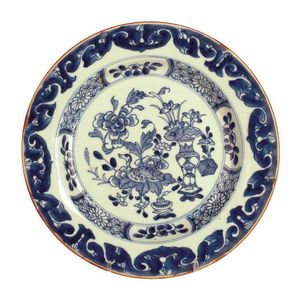Ming Dynasty Charger with Floral Decoration
You must be a subscriber, and be logged in to view price and dealer details.
Subscribe Now to view actual auction price for this item
When you subscribe, you have the option of setting the currency in which to display prices to $Au, $US, $NZ or Stg.
- Diaper Motif - The diaper motif is a repeating geometric pattern in decorative arts that consists of small diamond or lozenge shapes arranged in a grid. The pattern is often used as a background or border on textiles, ceramics, metalwork, and other decorative items. It can be found in a variety of cultures and historical periods, and is often used in formal or ornamental designs. The name "diaper" comes from the pattern's resemblance to the criss-crossed fabric of a baby's diaper.
- Crackling and Crackle as a Decorative Technique - Crackle, also known as crackling, is a decorative technique that has been used in China for centuries. It is believed to have originated during the Song Dynasty (960?1279 AD) and was primarily used in the production of ceramics, lacquerware, and furniture. The crackling effect was achieved by applying a glaze or lacquer that was formulated to crack during firing, creating a crackled pattern on the surface of the item.
During the Ming Dynasty (1368?1644 AD), crackle became a highly sought-after decorative technique, and it was used to create intricate and beautiful designs on ceramics and lacquer ware.
In Western decorative arts, crackle / crackling came into use during the Art Nouveau movement in the late 19th and early 20th century. The crackling effect was used to create a sense of movement and fluidity in the design of Art Nouveau pieces.
It was also used in the 1920s and 1930s during the Art Deco movement. - Roundel - A roundel is a circular disk, medallion or border on a plate or dish, on an object of furniture. A plate or dish will often have a central circular bordered decoration, termed a roundel. In furniture the word is often used instead of the word 'patera' to describe a turned circular decoration. In recent times use of the word has expanded to encompass any circular area on an object.
Visually similar items

Swatow Zhangzhou, Ming Dynasty charger, of circular form, with gentle sloping sides, the interior roundel decorated with floral spray, surrounded by reserves of flowers surrounded by a diaper ground, in iron red and green, on circular foot, diameter 33 cm,

17th century Ming Zhangzhou (Swatow) polychrome bowl in iron red, green and turquoise, decorated with a central bird in flight the wide border with medallions and dragons chasing the flaming pearl, 35 cm dia (one thumbnail rim chip)

A large 18th century Delft charger, hand painted with boats at sea, dated 1769. Faulted and repaired. Diameter 37 cm

A late 18th century/early 19th century Chinese blue and white export plate, decoration of flowering vase, florals and precious objects to the centre, decorated border with iron red edge, small old repairs to rim. Diameter 22.3 cm
